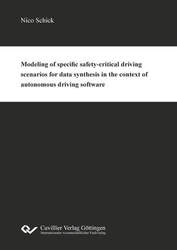| Areas | |
|---|---|
| Serie de libros (96) |
1378
|
| Nachhaltigkeit |
3
|
| Gesundheitswesen |
1
|
| Letra |
2365
|
| Ciencias Naturales |
5406
|
| Matemática | 229 |
| Informática | 319 |
| Física | 980 |
| Química | 1363 |
| Geociencias | 131 |
| Medicina humana | 243 |
| Estomatología | 10 |
| Veterinaria | 108 |
| Farmacia | 147 |
| Biología | 835 |
| Bioquímica, biología molecular, tecnología genética | 121 |
| Biofísica | 25 |
| Nutrición | 45 |
| Agricultura | 1004 |
| Silvicultura | 201 |
| Horticultura | 20 |
| Ecología y conservación de la tierra | 148 |
| Ciencias Ingeniería |
1793
|
| General |
98
|
|
Leitlinien Unfallchirurgie
5. Auflage bestellen |
|
Erweiterte Suche
Modeling of specific safety-critical driving scenarios for data synthesis in the context of autonomous driving software (Tienda española)
Nico Schick (Autor)Previo
Lectura de prueba, PDF (490 KB)
Autonomous driving is one of the key disciplines in the automotive field and currently under intensive development, especially with the objective of saving more people’s lives on the roads due to significant reductions in the number of traffic accidents. Therefore, the software components within autonomous cars must be tested efficient and precisely. One of the most challenging aspects of autonomous cars are the safety-critical driving scenarios. Their criticality has seldom been measured in terms of further forensic analysis or software solutions in the field of artificial intelligence. Therefore, data related to safety-critical driving scenarios must be obtained another way. In this context, kinematic models can be used to represent these scenes by describing the vehicle’s movements based on defined boundary constraints as well as providing synthesized data through the simulation of a model for the training and validation of the underlying machine learning algorithms, such as neural networks or generative algorithms. In this paper, three of the most significant safety-critical driving scenarios, namely emergency braking, turning, and overtaking, are modeled accordingly.
| ISBN-13 (Impresion) | 9783736972469 |
| ISBN-13 (E-Book) | 9783736962460 |
| Formato | A5 |
| Idioma | Inglés |
| Numero de paginas | 25 |
| Laminacion de la cubierta | mate |
| Edicion | 1 |
| Lugar de publicacion | Göttingen |
| Lugar de la disertacion | Esslingen |
| Fecha de publicacion | 06.08.2020 |
| Clasificacion simple | Tesis doctoral |
| Area |
Matemática aplicada
Informática Física teórica (incluyendo física de oscilacíon y olas) Ingeniería |
| Palabras claves | modeling, models, simulation, safety, safety-critical, safety-critical driving scenarios, safety-critical driving scenes, driving scenarios, driving scenes, scenarios, scenes, data synthesis, synthesized data, autonomous, autonomous driving, autonomous car, autonomous vehicle, autonomous software, autonomous driving software, modern vehicles, emergency braking, criticality, forensic analysis, artificial intelligence, machine learning, alternative data, training, validation, algorithms, reaction time, rarely recorded data, challenging driving, traffic accidents, traffic injuries, traffic deaths, car accidents, driver behaviour, technical systems, driver-assistance systems, automotive, automotive field, automotive sector, software, software components, software algorithms, lane changes, mathematical models, physical models, kinematic models, boundary constraints, vehicle’s movement, neural network, generative algorithm, turning, overtaking, opposing traffic, development, critical, underlying data, real measurements, measurements, key disciplines, Modellierung, Modelle, Simulation, Sicherheit, sicherheitskritisch, sicherheitskritische Fahrszenarien, sicherheitskritische Fahrszenen, Fahrszenarien, Fahrszenen, Szenarien, Szenen, Datensynthese, synthetisierte Daten, autonom, autonomes Fahren, autonomes Auto, autonomes Fahrzeug, autonome Software, autonome Fahrsoftware, moderne Fahrzeuge, Notbremsung, Kritikalität, forensische Analyse, künstliche Intelligenz, Maschinelles Lernen, alternative Daten, Training, Validierung, Algorithmen, Reaktionszeit, selten aufgezeichnete Daten, herausforderndes Fahren, Verkehrsunfälle, Verkehrsverletzte, Verkehrstote, Autounfälle, Fahrerverhalten, technische Systeme, Fahrerassistenzsysteme, Automobil, Automobilbereich, Automobilsektor, Software, Softwarekomponenten, Software-Algorithmen, Spurwechsel, mathematische Modelle, physikalische Modelle, kinematische Modelle, Randbedingungen, Fahrzeugbewegung, neuronales Netzwerk, generativer Algorithmus, Abbiegen, Überholen, Gegenverkehr, Entwicklung, kritisch, zugrunde liegende Daten, reale Messungen, Messungen, Schlüsseldisziplinen |








